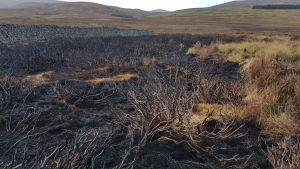The topic of burning was a key consideration in the IUCN UK Peatland Programme (IUCN UK PP) Commission of Inquiry on Peatlands (Bain et al., 2011) and led to a summary briefing on Burning on Peatbogs (IUCN UK PP, 2011). A more recent IUCN UK PP publication, Briefing Note No. 8: Burning (Lindsay et al., 2014), summarised the scientific evidence from an ecological perspective. This followed Natural England’s Review of Upland Evidence NEER004 (2013) and Natural England's Wildfire Evidence Review NEER014 (Glaves et al., 2020) on managed burning, and Peatbogs and Carbon (Lindsay, 2010). Our updated Position Statement (version 5) takes account of Natural England NEER155 (Noble et al., 2025). The Position Statement contains a full list of all the cited references. We recommend that readers looking to gain a broader understanding of the subject read a selection of these citations.
Key points:
- The overwhelming scientific evidence base finds that burning on peatlands causes damage to key peatland species, peatland ecosystem health, sustainability of peatland soils, and negative impacts on air and water quality.
- The majority of evidence finds no benefit to peatland ecosystem health in the UK from burning.
- Successful restoration of peatlands on hundreds of sites across the UK, without the use of fire, demonstrates that burning is not a necessary tool for peatland restoration. Burning is harmful to the prospects of the restoration of peat: repeated burning on already degraded areas further limits the growth of key peat forming species and hampers the recovery of the physical and hydrological properties of peat soils.
- Many plants are found within the peat matrix, but not all are able to create the conditions to form significant amounts of peat.
- In the context of a changing climate, the most effective long-term, sustainable solution for addressing increasing wildfire risk on peatlands is to return the sites to fully functioning bog habitat by removing those factors that can cause degradation, such as drainage, unsustainable livestock management and burning regimes. Despite a growing interest in using fire to reduce vegetation, there is currently no experimental field evidence from UK peatlands to suggest that burning is a valid wildfire management tool. Rewetting and restoring peatland will naturally, over time, remove the higher so-called ‘fuel load’ which arises from degraded peatland vegetation.
- Additional measures to control ignition risk and more effectively manage wildfire when it does occur will also be needed in tandem with any restoration action.
IUCN UK Peatland Programme video series on the effects of burning on blanket bogs:
Burning on Blanket Bogs Part 1: Effects of fire
Burning on Blanket Bogs Part 2: Recovery pathways
These animations are based largely on evidence from the experimental plots established on blanket bog at Hard Hill, Moor House National Nature Reserve, in 1954 (Hard Hill experimental plots on Moor House – Upper Teesdale National Nature Reserve – A review of the experimental set up (NECR321), Natural England, 2020). All the experimental plots were burnt at the start of the experiment in 1954. Some plots have since been left unburnt (but grazed or ungrazed) for the intervening 66 years, others have been burnt (with or without grazing) approximately every 20 years, while some have been burnt (with or without grazing) every 10 years.
Some of the ground outside the experimental plots is estimated (in 2020) to have been free from burning for around 100 years and appears now to be showing substantial signs of recovery from past burning events (all ground at Moor House is considered to have been subject to managed burning in the past). These recovery times are more akin to those of woodland restoration, though recovery times can be shortened substantially through the use of Sphagnum plug-planting.
Most of the images of actual sites used in the animation are from Hard Hill or from other areas of blanket bog subject to managed burning. Three of the images used are from examples of wildfire. References are available at the end of the video.
For further key documents see also:
The causes and prevention of wildfire on heathlands and peatlands in England (NEER014), Natural England, 2020
Grouse Moor Management Group: report - gov.scot, Werrity, 2019
IUCN UK Peatland Programme summary of the Burning Review, April 2025











